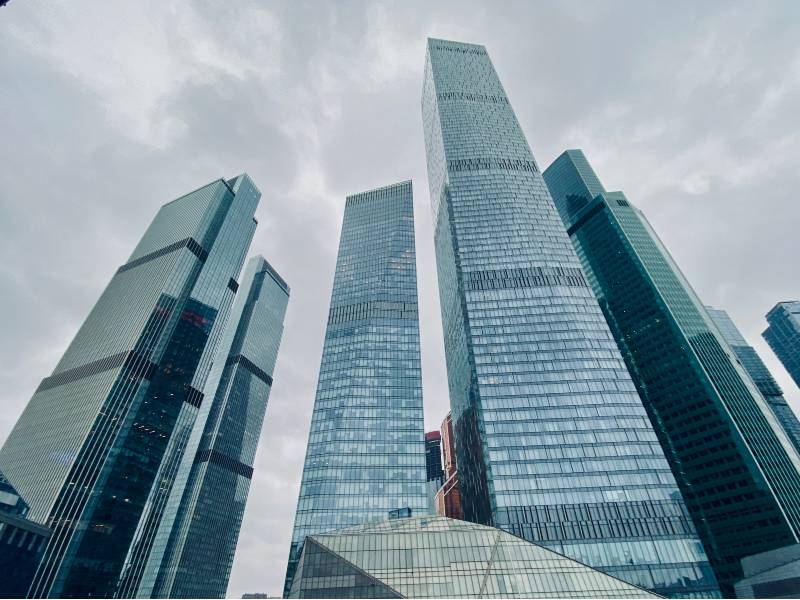As energy costs continue to rise and environmental concerns become more pressing, businesses of all sizes need to adopt energy-efficient practices in their commercial buildings. Not only can sustainable strategies save businesses money, but they also have the potential to improve occupant comfort and reduce carbon footprint.
This blog post will explore some of the tangible benefits of implementing an effective energy efficiency plan in your commercial building space. We’ll look at how making targeted changes today can result in improved air quality, greater operational cost savings, increased productivity levels, and much more. So if you’re looking to learn about optimizing your business’s energy performance now is an excellent time – let’s dive right into what measures are available!
According to energy.gov, Commercial buildings waste up to 30% of the energy they consume. This waste is often due to outdated equipment, inefficient use of lighting and HVAC systems, and a general lack of awareness about energy-saving practices. However, by taking proactive steps towards improving your commercial building’s energy efficiency, you can significantly reduce this number.
Key Takeaways
- Energy efficiency in commercial buildings not only leads to significant cost savings on utility bills but also plays a crucial role in reducing greenhouse gas emissions, contributing to a more sustainable environment.
- Implementing energy-efficient measures can enhance the overall lifespan and value of a building while ensuring a comfortable and productive environment for its occupants.
- While there are challenges in adopting energy efficiency, awareness, proper planning, and proactive measures like energy audits can pave the way for a greener and more sustainable commercial sector.
Table of Contents

Understanding Energy Efficiency
Definition and Concept
Energy efficiency represents the cornerstone of a secure, sustainable, and affordable energy future. It refers to the method of accomplishing the same tasks that require energy but with a reduced amount of energy. It’s a qualitative measure that builds on the idea of doing more with less – maximizing the output (work done, goods produced, services rendered) for any given input of energy.
This concept applies to a wide array of disciplines and contexts from industrial machines, household appliances, transport systems and even in power generation. A higher energy-efficient system or process implies less cost, less resource depletion, and less environmental impact, given the assumption that the work output remains the same.
For instance, a compact fluorescent light (CFL) bulb can provide the same amount of lighting as an incandescent bulb but uses a quarter to third of the energy. The CFL is more energy efficient. Over time, the cost savings in the energy used will offset the greater upfront cost of the CFL.
Energy Efficiency vs. Energy Conservation
Though at face value, energy efficiency and energy conservation measures for commercial buildings might seem to denote the same thing, they are fundamentally different concepts in the energy sector.
Energy efficiency aims at accomplishing the same tasks with less energy, as explained earlier, thus maximizing the benefits derived from each unit or quantity of energy. It focuses on reducing energy waste through the use of technological advancements, design, or processes that demand less energy.
On the other hand, energy conservation is geared towards reducing or eliminating the use of energy altogether. The primary ways of practicing energy conservation include changing behaviors, habits, or activities to minimize energy usage. This may involve turning off lights when leaving a room, reducing heating or cooling in buildings, or choosing to walk or cycle instead of driving a car.
While both approaches serve the common goal of minimizing energy usage, their strategies are distinct. Upgrading to an energy-efficient appliance is an act of energy efficiency, but using that appliance less frequently falls under energy conservation.
Thus, energy efficiency allows us to maintain the same level of comfort and lifestyle, with less energy, whereas energy conservation mainly entails reducing our energy demand by cutting back or avoiding unnecessary energy consumption. It is best to see both concepts as complementary strategies in the path towards a sustainable, energy-secure future.
Benefits of Energy Efficiency in Commercial Buildings
In today’s modern landscape, energy efficiency is a critical aspect of commercial property management, closely intertwined with sustainability. Implementing energy-efficient measures can offer an extensive range of benefits, impacting not only the economic aspects but also environmental and social metrics. Here, we explore several significant benefits of energy efficiency in commercial buildings.
Cost Savings on Utility Bills
Energy-efficient commercial buildings lead to significant reductions in utility bills, a direct result of decreased energy consumption. By investing in energy efficiency improvements (through techniques like improved insulation, energy-efficient appliances, and smarter HVAC systems), businesses can substantially lower their overall operational costs, freeing up resources for other business needs.
For instance, improved heating, ventilation, and air conditioning (HVAC) systems can reduce commercial building electricity consumption by 10% to 40%. Energy-efficient lighting can cut electricity consumption by up to 50%. These savings can eventually translate into increased profitability, making energy efficiency not just an environmental decision but a financially astute one as well.
Enhanced Building Lifespan and Value
The use of energy-efficient materials and technologies can also considerably prolong the lifespan of commercial buildings. These can include high-quality insulation, durable roofing, energy-efficient windows, and other materials designed for longevity. Consequently, lower maintenance and replacement costs add value to the building in the long run.
Moreover, commercial buildings with recognized energy-efficient certification or labeling systems, like LEED or Energy Star, tend to command higher rental or resale values. They are attractive to prospective tenants and buyers who wish to reduce their own environmental impact and enjoy the reduced operating costs that such buildings provide.
Improved Indoor Air Quality and Comfort
Energy-efficient buildings are not just about cost and environmental benefits; they also directly benefit the occupants. Improved windows, better insulation, and efficient HVAC energy consumption in commercial buildings systems can greatly enhance indoor air quality and temperature regulation, providing a healthier, more comfortable indoor environment for employees, visitors, or residents.
High-quality indoor environments can lead to increased productivity, reduced sick days, and improved occupant satisfaction. Additionally, meeting green building standards often means incorporating superior ventilation systems that can significantly improve indoor air quality by reducing pollutants such as volatile organic compounds (VOCs) and carbon dioxide.
Reduction in Greenhouse Gas Emissions
Equally importantly, energy-efficient commercial buildings play a crucial role in our global push towards mitigating climate change. They contribute towards reducing greenhouse gas emissions by consuming less energy sourced from fossil fuels – the primary contributor to global warming.
Significant energy reductions in commercial buildings could lead to a substantial decrease in CO2 emissions. This resonates even more strongly as commercial buildings account for nearly 40% of all energy use and associated greenhouse gas emissions in most developed countries. commercial energy conservation initiatives offer a powerful and achievable pathway to reducing our carbon footprint and advocating for environmental sustainability.
Taking steps to enhance energy efficiency in commercial buildings opens up a spectrum of opportunities – from operational cost savings and improved building value to superior indoor air quality and a meaningful reduction in greenhouse gas emissions. It is an investment that pays off significantly, benefiting the organization, the occupants, and indeed, our planet.
Challenges in Implementing Energy Efficiency
While the benefits of energy efficiency are clear and compelling, the path to implementing energy-efficient measures is not without its hurdles. Successful promotion and adoption of energy efficiency require overcoming a set of considerable challenges, from economic constraints to educational gaps and institutional resistance.
Initial Investment Costs
One of the most significant barriers to implementing energy efficiency is the initial investment cost. Energy-efficient equipment, technologies, and building modifications typically require a high upfront capital investment. While these investments offer substantial long-term savings and a positive return on investment, they can be a daunting financial hurdle for many businesses and homeowners.
For example, installing energy-efficient heating and cooling systems, upgrading insulation, or replacing old appliances with energy-efficient ones all require substantial upfront expenditure. Due to these costs, businesses and individuals often opt for lower-cost, less efficient alternatives that require less immediate spending but result in higher operational costs over time.
Lack of Awareness and Understanding
Another key challenge is the widespread lack of awareness and understanding about energy efficiency and its benefits. This knowledge gap impedes the adoption of energy-efficient practices and technologies, as those unaware of the benefits or how to achieve them are unlikely to take the necessary actions.
Educational programs, marketing campaigns, and public information initiatives can play crucial roles in overcoming this barrier. However, these efforts require continual resources, strategic planning, and consistent messaging to engage various target audiences to increase understanding, change attitudes, and ultimately drive action towards energy efficiency.
Resistance to Change
Resistance to change is a common challenge in many sectors, and energy is no exception. Institutional inertia and individual habits can create significant blocks to implementing new energy-efficient practices or technologies. Often, people are comfortable with their existing habits and systems, even if they are inefficient.
Businesses, in particular, may resist changes that could disrupt operations or require retraining staff. Moreover, managers and decision-makers may oppose energy-efficient initiatives if they perceive them as risky or are unfamiliar with the specifics.
In both scenarios, effective change management principles, such as securing management buy-in, providing extensive communication and training, and having champions of change, can help enact energy efficiency measures.
Addressing these obstacles requires various strategies, from financial incentives that alleviate initial costs to educational initiatives that raise awareness and understanding to internal champions and change management techniques that tackle resistance to change. Overcoming these challenges will pave the way for broad-scale implementation of energy efficiency, unlocking its many economic, social, and environmental benefits.
Case Studies: Success Stories
It’s always important to see real-world examples to truly comprehend the impact of energy efficiency in commercial buildings. Here are two case studies that demonstrate the multi-faceted benefits of energy efficiency.
The Empire State Building, New York City
Perhaps one of the most iconic examples of energy efficiency at work is the Empire State Building in New York City. In 2009, the building underwent a massive green retrofit that aimed to reduce its energy consumption significantly. The retrofit involved upgrading the building’s windows, implementing insulation measures, and installing smart building systems to enhance overall energy management.
The upgrades resulted in a 38% reduction in energy consumption, equating to annual savings of $4.4 million. Additionally, the retrofit has reportedly cut carbon dioxide emissions by 105,000 metric tons over the past decade. The initial investment of $13 million was expected to be recouped in just over three years through energy savings, showcasing an outstanding return on investment.
Furthermore, the retrofit had a significant impact on enhancing building value and occupants’ health and well-being. The EPA estimates that energy-efficient buildings command rent premiums of up to 20% over conventional buildings, and the Empire State Building has certainly benefited from this.
PNC Tower, Pittsburgh, PA
Pittsburgh’s PNC Tower, often known as the “greenest office building in the world,” is another noteworthy example. The tower has been designed with sustainability and energy efficiency at its core, featuring advanced systems such as a solar chimney, a double-skin façade, and a sophisticated network of sensors that adjust the building’s lighting and temperature based on the occupancy and weather.
The result is a building that consumes 50% less energy than a comparable commercial building. The building also has access to fresh air for 42% of working hours through a natural ventilation system, improving indoor air quality and comfort for occupants.
In addition to the significant cost savings through lower energy bills, the building also commands premium rents and has given the PNC Financial Services Group a compelling brand association with sustainability and corporate responsibility.
These examples demonstrate that while the up-front costs of making a commercial building more energy efficient can be high, the long-term advantages are sizeable – from reduced utility bills and lower emissions, increased building value and rent premiums, to enhanced occupant comfort and health benefits. Implementing energy efficiency is both a viable and an advantageous strategy for commercial buildings in today’s world.
Steps to Improve Energy Efficiency
Improving energy efficiency in commercial buildings is paramount for the reduction of resource consumption, environmental impact, and operational cost savings. The following steps provide a roadmap for businesses and property owners seeking to create more energy-efficient buildings.
Conduct Energy Audits
An energy audit is an essential first step to understanding how energy is used in a building and identifying opportunities for improvement. Energy audits involve a systematic evaluation of the building’s energy consumption by a professional energy auditor or specialist. They assess various systems and equipment, such as HVAC, lighting, water heating, and appliances, to detect energy inefficiencies.
Energy audits provide building owners with valuable data, including benchmarks against similar buildings, energy usage patterns, and specific recommendations for improvements tailored to the building’s needs. The audits can range from basic walkthrough assessments to comprehensive audits that include detailed analysis and modeling.
How to Reduce Energy Consumption In Commercial Buildings
Once the audit has identified areas for improvement, the next step is to implement retrofitting measures and upgrades. This can include:
- Lighting: Replace old incandescent or halogen bulbs with energy-efficient LEDs or CFLs. Installing occupancy sensors, daylight controls, and timers can also reduce energy consumption by turning off lights when they are not needed.
- HVAC: Upgrade heating, ventilation, and air conditioning systems to high-efficiency, Those with ENERGY STAR certification. Consider implementing temperature set points and recognizing seasonal fluctuations, as well as maintaining and cleaning systems regularly to ensure optimal performance.
- Insulation: Enhance insulation in walls, roofs, and windows to reduce heat loss in winter and heat gain in summer.
- Windows and Doors: Replace old windows and doors with energy-efficient, double- or triple-glazed options. Sealing drafts and gaps can also help in maintaining consistent indoor temperatures.
- Water heating: Upgrade to energy-efficient water heaters or consider alternative solutions like solar water heaters or heat pumps.
- Appliances and Equipment: Replace dated appliances and equipment with newer, energy-efficient models based on energy usage and lifecycle analysis.
Planning the upgrades based on return on investment, budget, and impact is crucial to ensure optimal results.
Adopting Green Building Practices
In addition to specific retrofits and upgrades, implementing green building practices is essential for improving energy efficiency holistically. Some of these practices include:
- Building Automation Systems: Incorporate building automation systems that monitor and control energy consumption and allow for intelligent scheduling, adjusting, and optimizing based on factors such as occupancy, weather, and equipment performance.
- Passive Solar Design: Optimize building orientation, window placement, and shading devices to maximize the use of daylight and passive solar heating.
- Cool Roofs and Green Roofs: Install cool roofs or green roofs to minimize heat gain and reduce cooling loads in the summer months.
- Renewable Energy: Utilize on-site renewable energy sources, such as solar panels, wind turbines, or geothermal systems, to reduce reliance on fossil fuels and minimize energy costs.
- Water Efficiency and Conservation: Implement water-saving fixtures and efficient landscape irrigation systems. Consider rainwater harvesting, grey water recycling, and water-efficient appliances to reduce water usage and wastewater generation further.
By following these steps, building owners can significantly improve the energy efficiency of their properties, reaping a wide array of environmental, economic, and social benefits in the long run.
The Future of Energy Efficiency in Commercial Buildings
The future of energy efficiency in commercial buildings is shaped by a diverse array of factors, with technological advancements and government policies playing significant roles. As these elements continue to evolve, businesses and property owners must adapt to stay competitive, minimize operational costs, and reduce their environmental footprint.
Technological Advancements on the Horizon
Emerging technologies and innovations are set to have a substantial impact on energy efficiency in commercial buildings, offering new opportunities to push the boundaries of design, construction, and operation. Some of the key technological advancements include:
- Internet of Things (IoT): IoT technology allows for the interconnection of various building systems and devices, offering real-time monitoring and remote control of energy consumption. By providing granular control and data analysis, building operators can optimize the operation of HVAC, lighting, and other systems for maximum efficiency.
- Artificial Intelligence (AI) and Machine Learning: AI-driven software can analyze vast amounts of data from connected devices and sensors to identify inefficiencies, detect patterns, and optimize the scheduling and operation of building systems. Machine learning can continually adapt to changing conditions and requirements, improving energy management and reducing energy waste.
- Smart Grids and Energy Storage: An increasing number of commercial buildings are being integrated with smart grids, enabling bidirectional energy exchange and load shifting to minimize peak demand on the grid. Moreover, energy storage technologies, such as batteries, are becoming more cost-effective, offering a means to store excess renewable energy for later use in the building.
- Advanced Building Materials: New developments in materials science are creating more energy-efficient building materials, such as phase-change materials, electrochromic glass, and ultra-efficient insulations, resulting in reduced energy loss, enhanced thermal comfort, and lower energy costs.
The Role of Government and Policy
Governments and policymakers play a crucial role in driving the adoption of energy efficiency measures in commercial buildings. As the urgency of climate change and resource depletion intensifies, there is an increasing emphasis on policy actions that support and promote sustainable building practices. Some key policy actions include:
- Energy Performance Standards: Governments can set stringent energy performance standards for both new and existing buildings, driving improvements in design, construction, and operation. These measures can take the form of building codes, minimum energy performance requirements, or mandatory energy labeling schemes.
- Incentives and Rebates: Policymakers can offer financial incentives and rebates to encourage businesses and property owners to invest in energy-efficient technologies and practices. These incentives can help offset the initial costs of energy-efficient retrofits and upgrades, making them more attractive to building owners.
- Carbon Pricing and Emissions Trading: Establishing carbon pricing mechanisms and emissions trading schemes can incentivize businesses to reduce their overall energy consumption and carbon emissions, as more efficient buildings would lead to lower carbon costs.
- Education and Training: Governments can facilitate awareness campaigns, education initiatives, and targeted training programs that educate building owners, operators, and occupants on the benefits of energy efficiency and how to best achieve it.
The future of energy efficiency in commercial buildings is bright as advancements in technology and supportive government policies continue to drive adoption. By staying ahead of these developments and taking full advantage of them, businesses and property owners can significantly improve their buildings’ energy efficiency, benefiting both the environment and their bottom line.

The Importance of Energy Efficiency in Commercial Buildings FAQs
What is the difference between energy efficiency and energy conservation?
Energy efficiency refers to the use of technology and practices that reduce the amount of energy required to perform a specific function. It focuses on maximizing output while minimizing input, resulting in less energy waste. On the other hand, energy conservation involves reducing energy consumption in commercial buildings and overall energy consumption through behavioral changes or modifications in activities and processes.
How much can a commercial building save on utility bills with energy efficiency?
The exact amount a commercial building can save on utility bills with energy efficiency measures will vary depending on the size, location, and current commercial building energy consumption of the building. However, studies have shown that implementing energy efficiency measures can result in savings of up to 30% on utility bills.
Are there tax incentives or rebates available for energy-efficient upgrades?
Yes, there are often tax incentives and rebates available for energy-efficient upgrades in commercial buildings. These incentives vary by location and may be offered at the federal, state, or local level. It is essential to research and take advantage of any available incentives to offset the initial costs of energy-efficient upgrades. Overall, incorporating commercial real estate energy efficiency measures into commercial buildings can bring numerous benefits
How does energy efficiency improve indoor air quality?
Energy efficiency measures, such as proper insulation and air sealing, can prevent outside pollutants from entering a building, improving indoor air quality. Additionally, efficient HVAC systems can maintain optimal humidity levels, reducing the likelihood of mold growth and other air quality issues.
What is an energy audit and why is it important?
An energy audit is a comprehensive assessment of energy use in commercial buildings and potential areas for improvement. It can identify inefficiencies, prioritize energy-saving measures and provide cost-benefit analyses. Energy audits are important as they help building owners make informed decisions about where to invest in commercial energy efficiency upgrades, maximizing their impact and return on investment.
Conclusion
Energy efficiency in buildings, these projects like commercial buildings are beneficial to both the environment and budgets alike as they reduce greenhouse gas emissions and can help create a comfortable and productive work environment. Those already in possession of a building must properly plan out their energy-efficiency objectives, and an energy audit can provide helpful direction.
As a real estate professional, I recommend that all those looking to invest in commercial real estate reach out to me for a free consultation to determine the best course of action. So, take Charge of your energy goals and reduce your carbon footprint. You’ll also save energy and money on utility bills while increasing the value of your building. Call or schedule a free consultation with me today to learn more about how you can make your building energy efficient!




